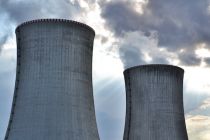Radiations.
Il semble que je ne sois pas le seul qui soit inquiet. Et que je ne sois pas le seul qui n'ait pas d'information ni de connaissances dans le sujet. Et pas le seul non plus qui ne fasse pas confiance à nos gouvernements. Ils nous disent qu’ils veulent éviter la panique en ne donnant pas d’informations au public … ces béotiens.
C’est un peu la mentalité de l’establishment financier aussi. Dites au petit investisseur de ne pas paniquer car il ne peut comprendre … Et dites-lui qu’il ne peut comprendre en continuant toujours de lui donner le moins d’information possible.
Passez même des règlements et des lois pour assurer que la population ne puisse voir la vérité, les vrais chiffres, les vrais dettes, les véritables déficits, la vraie valeur des « level 3 assets » qui sont essentiellement des produits dérivés complexes … et de toute évidence trop complexes pour ces génies de la finance et nos gouvernements car avec ça ils ont brisé le système.
Haaa mais avec le nucléaire ce n’est pas pareil. Ils n’oseront pas nous tromper me dit-on ! Pas sûr … Pas sûr du contraire non plus, mais pas sûr.
Malheureusement, je n’ai pas d’idée claire pour l’instant au sujet de l’impact potentiel de cette crise japonaise sur l’économie mondiale ou sur celle du Japon. Il y a plus d’inconnu que quoi que ce soit.
Voici un bout de texte provenant de CNBC :
Radiation Fears Grow From Stricken Japan Nuclear Plant
Published: Tuesday, 22 Mar 2011 | 10:56 PM ET
By: Reuters
Further contamination of vegetables added to global anxiety on Wednesday at radiation from Japan's tsunami-smashed nuclear plant where engineers are struggling to cool reactors in the world's worst atomic crisis for 25 years.
Above-safety radiation levels have now been discovered in 11 types of vegetables from the Fukushima area in north-east Japan where the six-reactor plant was battered by a March 11 earthquake and tidal wave, the government said. Radiation has also been found in milk, tap water and the nearby Pacific sea, though Japan and experts insist levels are still far from dangerous to humans.
The Asian nation's worst crisis since World War Two has caused an estimated $250 billion damage, sent shock waves through global financial markets, and left nearly 23,000 people dead or missing, mostly from flattened coastal towns.
More than a quarter of a million people are living in shelters, while rescuers and sniffer dogs continue to comb debris and mud looking for corpses and personal momentoes.
Worsened by widespread ignorance of the technicalities of radiation, public anxiety has been growing round the world.
U.S. regulators announced import restrictions on contaminated milk and spinach from four Japanese prefectures, Japan's Jiji news agency said on Wednesday.
Japan has already halted shipment of some food from the area and Asian neighbors are inspecting imports for contamination.
Vienna-based U.N. watchdog, the International Atomic Energy Agency (IAEA), expressed concern about a lack of information from Japanese authorities. It cited missing data on temperatures of spent fuel pools at the facility's reactors 1, 3 and 4.
"We continue to see radiation coming from the site ... and the question is where exactly is that coming from?" added a senior IAEA official James Lyons.
Although there has been progress in restoring power to the Fukushima site 13 days after the accident, plant operator Tokyo Electric Power (TEPCO) said it needed more time before it could say the reactors were stabilized. Technicians working inside an evacuation zone around the plant, 250 km (150 miles) north of Tokyo, have successfully attached power cables to all six reactors and started a pump at one to cool overheating nuclear fuel rods.
Smoke and steam rising from two of the most threatening reactors, No. 2 and No. 3, have caused alarm in recent days, but had stabilized again on Wednesday. Experts say the steam blasts have probably released a small amount of radioactive particles.
Concern is high over the core of reactor No. 1 after its temperature rose to 380-390 Celsius (715-735 Fahrenheit), TEPCO executive vice president Sakae Muto said. The reactor was built to run at a temperature of 302 C (575 F).
As well as having its engineers on the front line in highly dangerous circumstances, TEPCO is also facing accusations of a slow disaster response and questions over why it originally stored more uranium at the plant than it was designed to hold.
US Concern for Troops
U.S. Defense Secretary Robert Gates said he was concerned about radioactive fallout affecting the 55,000 troops in and around Japan, many involved in a massive relief operation for Washington's close ally.
"We're very concerned about the health of our men and women in uniform," he said. "But we're also deeply concerned about the wellbeing of our Japanese allies." Japanese Prime Minister Naoto Kan said people in Fukushima prefecture should stop eating leafy vegetables and halt shipments of milk and parsley, Kyodo news agency said.
Some radioactive particles thought to be from Fukushima have been detected as far away as Iceland, diplomatic sources said.
They stressed the tiny traces, measured by a network of international monitoring stations as they spread eastwards from Japan across the Pacific, North America, the Atlantic and to Europe, were far too low to cause any harm to humans.
"It's only a matter of days before it disperses in the entire northern hemisphere," said Andreas Stohl, a senior scientist at the Norwegian Institute for Air Research.
The Japan crisis has dealt a blow to the nuclear power industry around the world. Italy became the latest nation to re-assess its program, announcing a one-year moratorium on site selection and building of plants.



















